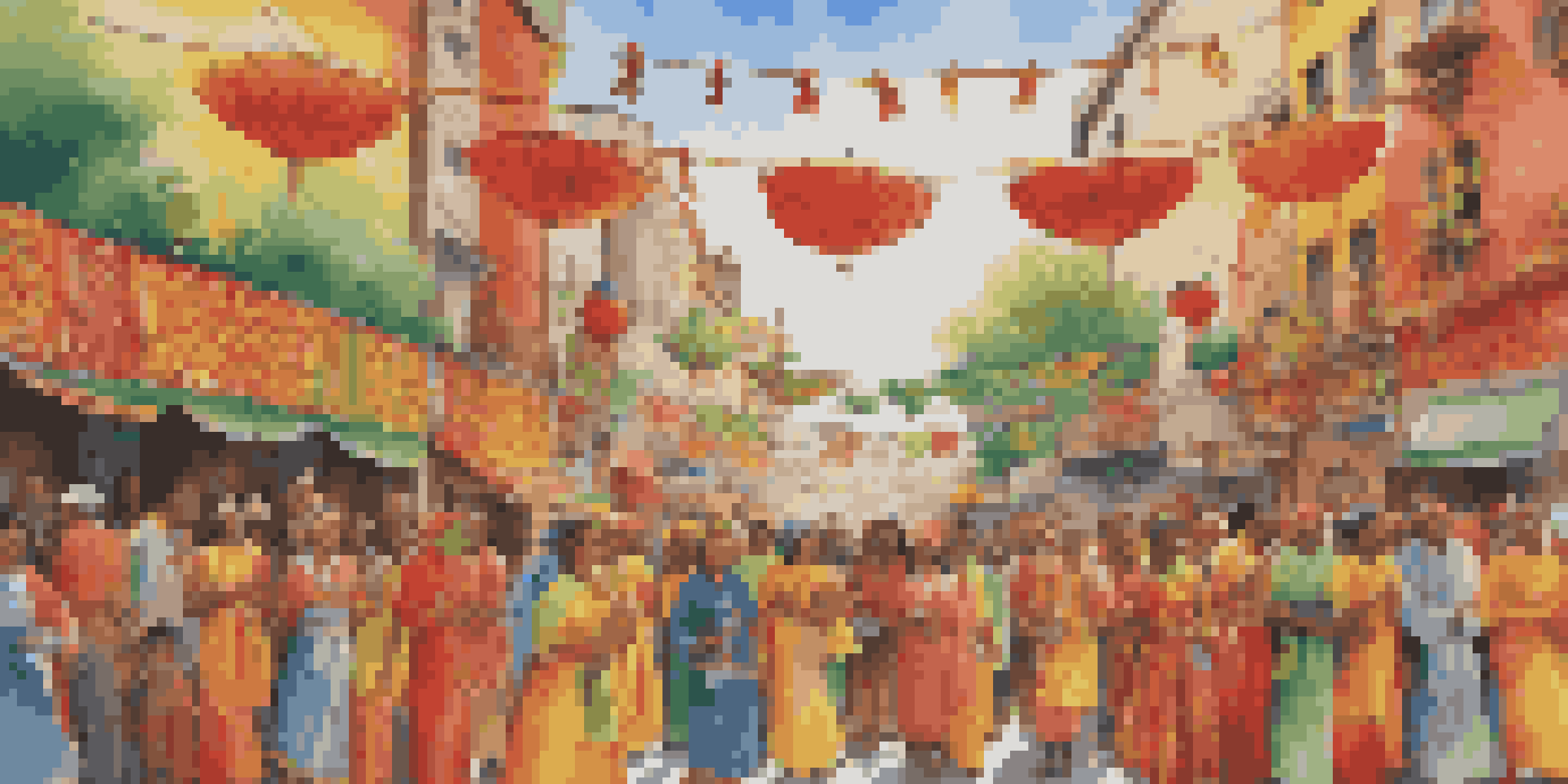Cultural Identity in Art and Literature: A Comparative Study

Understanding Cultural Identity in Art and Literature
Cultural identity refers to the sense of belonging to a group that shares a common culture, including language, traditions, and values. In both art and literature, this identity often serves as a powerful backdrop, influencing the themes and styles of the works created. By exploring how artists and writers express their cultural backgrounds, we can gain deeper insights into their motivations and messages.
Art is the most beautiful of all lies; it is a truth that is revealed to us through the lens of culture.
For instance, a painter from a marginalized community may use vibrant colors and traditional motifs to convey their heritage, while a novelist might weave personal experiences rooted in cultural history into their narrative. These artistic choices not only reflect individual experiences but also resonate with collective memory, making cultural identity a central theme. Understanding this connection enriches our appreciation of the work and its context.
Moreover, the exploration of cultural identity in art and literature can foster dialogue and understanding among diverse groups. It encourages audiences to reflect on their cultural backgrounds and recognize the shared human experiences that bind us all, illustrating how art transcends barriers and unites people across different cultures.
Art: A Visual Representation of Cultural Heritage
Art serves as a visual narrative that captures the essence of cultural identity. Through various mediums, artists express their unique perspectives, often rooted in their cultural backgrounds. For example, indigenous artists might incorporate traditional symbols and storytelling techniques that reflect their heritage, allowing viewers to connect with their histories.

The use of color, form, and symbolism in art can evoke emotions and provoke thought, making cultural heritage accessible to a broader audience. This visual language often transcends linguistic barriers, enabling people from different backgrounds to engage with the work. When we admire a piece of art, we are not just appreciating its aesthetics; we are also experiencing a cultural dialogue.
Cultural Identity Shapes Art & Literature
Art and literature reflect and express cultural identity, providing insights into the values and experiences of different communities.
Additionally, art exhibitions and cultural festivals provide platforms for underrepresented voices, allowing artists to showcase their heritage and stories. This not only promotes cultural appreciation but also challenges stereotypes and fosters inclusivity, highlighting the importance of diverse narratives in our global society.
Literature: Weaving Cultural Narratives into Storytelling
Literature serves as a powerful tool for exploring and expressing cultural identity through storytelling. Writers often draw from their personal experiences, weaving intricate narratives that reflect their cultural backgrounds. These stories can range from historical accounts to contemporary experiences, providing a rich tapestry of voices and perspectives.
Literature is the art of discovering something extraordinary about ordinary people, and saying with ordinary words something extraordinary.
For instance, authors from immigrant backgrounds may write about the struggles of assimilation and the duality of identity, allowing readers to empathize with their journeys. Through relatable characters and authentic dialogues, literature becomes a means of bridging cultural divides, fostering understanding and compassion among readers from diverse backgrounds.
Moreover, literary works often preserve cultural heritage by documenting traditions, folklore, and languages that might otherwise fade away. By reading these stories, we not only engage with the author's cultural identity but also contribute to the preservation of that culture, ensuring it continues to resonate with future generations.
Comparative Analysis: Art vs. Literature in Cultural Expression
While both art and literature serve to express cultural identity, they do so through different mediums and techniques. Art relies on visual elements to convey emotions and stories, while literature uses language to build narratives and create character depth. This fundamental difference shapes how each medium engages the audience and communicates cultural themes.
For example, a painting might capture a fleeting moment in a cultural festival, evoking an immediate emotional response, while a novel could delve into the intricacies of that festival's significance over generations. This comparison highlights the unique strengths of each medium, emphasizing the diverse ways cultural identity can be represented and understood.
Art Fosters Cultural Dialogue
Through visual narratives, art transcends language barriers and encourages conversations about shared human experiences across diverse cultures.
Exploring these differences can deepen our appreciation for both forms of expression. By recognizing how artists and writers approach cultural identity, we can better understand the multifaceted nature of culture itself and the various ways it influences our world.
Cultural Identity in Global Art Movements
Global art movements often reflect the cultural identities of the societies from which they emerge. For instance, the Harlem Renaissance was a cultural and artistic explosion in the African American community that celebrated black identity and heritage through literature, music, and visual arts. This movement not only influenced American culture but also had a ripple effect worldwide, inspiring artists globally to embrace their cultural roots.
Similarly, movements like Mexican Muralism highlighted social issues and cultural pride through large-scale public murals, serving as a visual testament to the struggles and triumphs of the Mexican people. These art forms became a way for artists to express their cultural identity while also engaging with broader social and political issues.
By studying these movements, we can see how cultural identity shapes artistic expression and serves as a reflection of societal values. This understanding encourages us to appreciate the diversity within the global artistic landscape and recognize the important role cultural identity plays in shaping our shared human experience.
The Role of Cultural Identity in Contemporary Art and Literature
In contemporary art and literature, cultural identity continues to be a significant theme that resonates with audiences around the world. Many modern artists and writers explore their cultural backgrounds, addressing issues such as globalization, migration, and identity politics. This exploration not only reflects personal experiences but also engages with larger societal conversations.
For example, contemporary literature often grapples with the complexities of identity in a multicultural world, where individuals navigate multiple cultural influences. Similarly, artists may create works that challenge cultural stereotypes, inviting viewers to reflect on their own perceptions and experiences. This dynamic interplay between culture and identity is essential for fostering understanding and empathy in our increasingly interconnected world.
Contemporary Themes in Cultural Works
Modern artists and writers explore cultural identity amidst globalization and identity politics, inviting audiences to engage with diverse perspectives.
Moreover, the rise of digital platforms has allowed diverse voices to emerge, providing a space for artists and writers to share their cultural narratives. This democratization of art and literature enables a more inclusive representation of cultural identity, inviting audiences to engage with stories and perspectives that may have been marginalized in the past.
Conclusion: The Power of Art and Literature in Shaping Identity
Art and literature are powerful mediums that not only allow for the expression of cultural identity but also shape our understanding of it. They serve as vehicles for storytelling, bridging cultural divides and fostering connections among individuals from different backgrounds. By engaging with these forms of expression, we can appreciate the richness of diverse cultures and the unique identities that emerge from them.
Moreover, as we explore cultural identity in art and literature, we are reminded of the importance of representation in shaping perceptions and narratives. When artists and writers share their cultural stories, they contribute to a broader dialogue about identity and belonging, challenging stereotypes and promoting inclusivity.

Ultimately, the comparative study of cultural identity in art and literature invites us to celebrate our differences while recognizing our shared humanity. It encourages us to engage thoughtfully with artistic expressions, fostering a deeper appreciation for the diverse cultural tapestry that enriches our world.